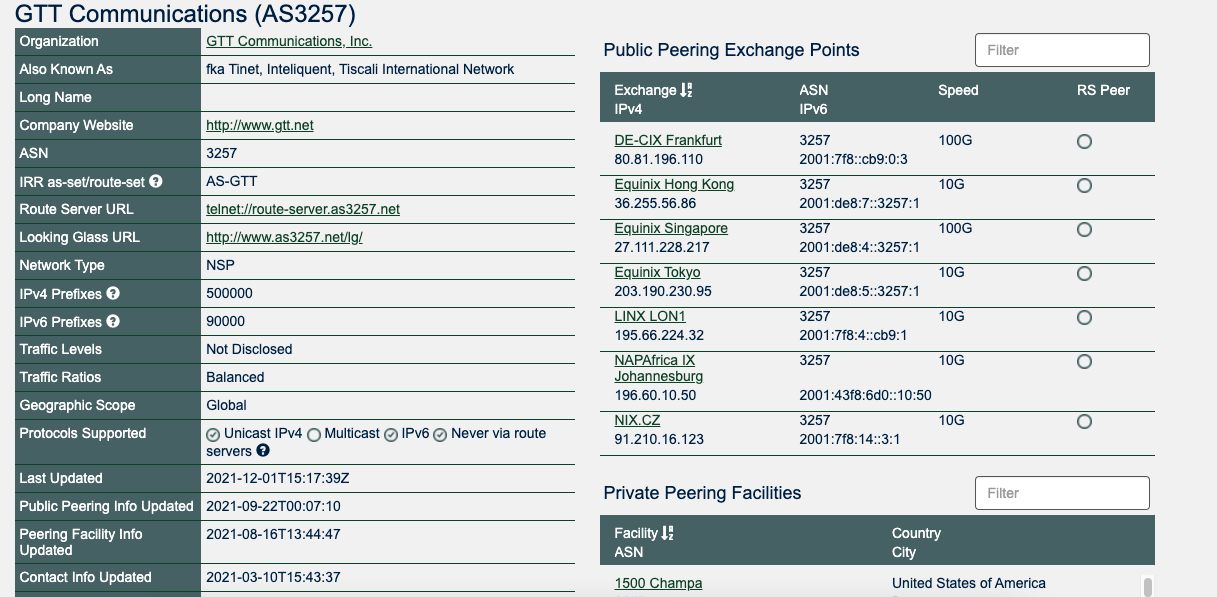What is Peering
Why Peering shapes traffic with networks
Definition of Peering
Peering provides two or more disparate autonomous internet networks the ability to route traffic directly to each other. Typically, this exchange allows the providers to route directly without having to pay each other or a third party for this traffic over the internet. Many organizations are very interested in a network’s ability to secure private peering and the capacity to those upstream networks. Establishing this private interchange is only as good as the capacity between each other.
What Peering options Exist today?
Once two networks connect how they are working as a tandem varies. Often, larger telecom providers are in the same building where a common entry point for BGP exists. Direct connections between each other is one method, however this does not scale as expansion is required across the globe.
Public peering
Public peering is often glossed over in network design circles. This type of connection is frequently performed at a Public Internet Exchange Point. The Benefits of Public Peering can help accelerate direct connectivity providing faster routing as traffic is kept local between two networks. Another huge benefits is it’s much cheaper as both networks are routing traffic directly to each other.
Private peering
Private peering takes place in datacenters, usually independent ones such as Equinix or carrier hotels where both networks can separate their traffic and directly connect to each other. This provides fast and reliable ways to balance traffic in a peering relationship. Traffic balance is important because the receiving network from a downstream must be allowed to equally send the same amount of traffic back, otherwise it can cause issues.
5G Peering – will it be impacted?
5G networks are still in the infancy of rollout and complete standards definition. The handful (yes, at this writing there will not be as many 5G providers) of carriers and private organizations (AWS launches it’s private 5G Network) will need to carefully deploy and peer with upstream providers as their buildout continues. Once could argue, the deployment of wireless 5G might allow carriers an easier deployment to an wireline peer simply due to gear placement. Time will tell, however in the meantime organizations should be cautious for that same reason. If 5G access points require rooftop access at the IXP, some cities/town and landlords have strict guidelines not to mention interference they must contend with vs. wireline backbones.
AWS announced a fully private 5G wireless network to support connectivity remotely to their cloud. Private wireless networks similar to a public network, it requires spectrum which. AWS’ 5G appears to be an using a Citizens Broadband Radio Service (CBRS) band. networks.
How Peering Works
Most organizations as mentioned partner & peer at a designated IXP which is usually a 3rd Party Datacenter or Carrier Hotel. This affords companies a secure, temperature controlled facility to collocate their peering routers together. Any entity looking to peer with a carrier aka backbone provider, must follow their application and deployment process.
Most carrier peering agreements require the following to be met:
- BGP& a Layer 3 device such as dual router set.
- A publicly routed ASN assigned to their organization
- A minimum of a Class C /24 publicly routable IPs
Peering Tools
One great useful looking glass tool is PeeringDB which allows anyone to see the overview of a carrier. Many will tout they are a “Tier-1” backbone but with a little digging you can see what’s really under the hood. Here’s an example of GTT’s AS3257 summary on PeeringDB. It provides great information on the amount of Prefixes, ASN and IXP across the globe.

Conclusion
Oraganizations should take notei
Recent Posts
- Tier 1 vs Tier 2 vs Tier 3 ISPs Explained: The Complete Guide for IT Leaders
- America’s AI Action Plan 2025: What CEOs, CIOs, and CFOs Need to Know
- The AIoT Advantage: Harnessing the Convergence of Artificial Intelligence and the Internet of Things
- Quack AI Governance in the Age of Algorithmic Hype
- NVIDIA Corporation: A Strategic Analysis for Business Executives Navigating the AI Ecosystem
Archives
- August 2025
- July 2025
- June 2025
- May 2025
- April 2025
- March 2025
- February 2025
- January 2025
- December 2024
- November 2024
- October 2024
- September 2024
- August 2024
- July 2024
- June 2024
- May 2024
- April 2024
- March 2024
- February 2024
- January 2024
- December 2023
- November 2023
- October 2023
- September 2023
- August 2023
- July 2023
- June 2023
- May 2023
- April 2023
- March 2023
- February 2023
- January 2023
- December 2022
- November 2022
- October 2022
- September 2022
- August 2022
- July 2022
- June 2022
- May 2022
- April 2022
- March 2022
- February 2022
- January 2022
- December 2021
- November 2021
- October 2021
- September 2021
- August 2021
- July 2021
- June 2021
- May 2021
- April 2021
- March 2021
- December 2020
- September 2020
- August 2020
- July 2020
- June 2020
Categories
- All (19)
- Satellite (1)
- Artificial Intelligence (7)
- Travel (1)
- Sports (1)
- Music (1)
- News (275)
- Design (3)
- Clients (12)
- Uncategorized (1)
- Tips & tricks (25)
- Inspiration (9)
- Client story (1)
- Unified Communications (196)
- Wide Area Network (309)
- Cloud SaaS (60)
- Security Services (71)




